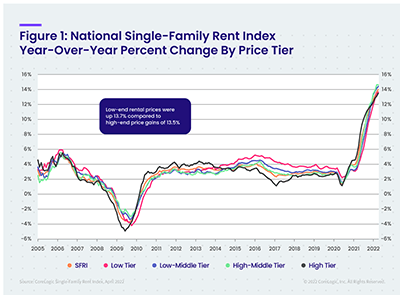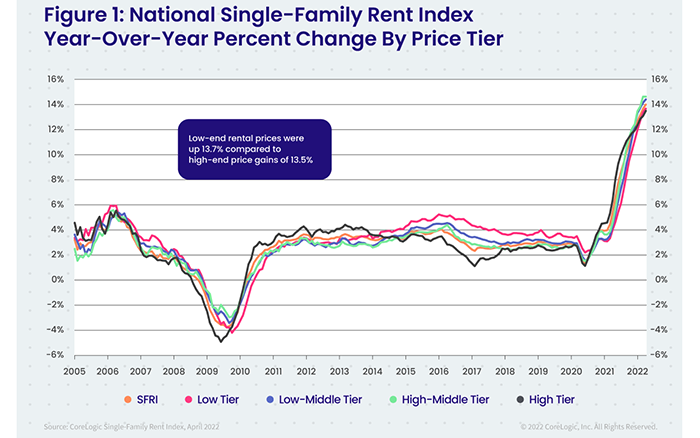
Single-Family Rent Growth Sees 13th Consecutive Record-Breaking Month

CoreLogic, Irvine, Calif., said U.S. single-family rent growth continued its hot streak in April, with prices up by 14 percent year-over-year for the thirteenth consecutive month of record-breaking annual gains.
Just as in in past months, a shortage of rental properties on the market is putting pressure on prices, as is a thriving job market, CoreLogic said. The nation’s economy added nearly 430,000 new positions in April and there was a 5.5 percent annual wage increase.
The year-over-year U.S. rent price growth once again was more than double the April 2021 increase and more than six times higher than the April 2020 growth, CoreLogic said in its monthly Single-Family Rent Index report. Rental cost gains slowed in early 2020 due to the uncertainty surrounding the coronavirus pandemic but rebounded by autumn of that year to surpass the pre-pandemic rate.

“Single-family rents continue to increase at record-level rates,” said Molly Boesel, Principal Economist with CoreLogic. “In April, rent growth provided upward pressure on inflation, which rose at rates not seen in nearly 40 years.”
Boesel noted she expects single-family rent growth to continue to increase “at a rapid pace” throughout 2022.
CoreLogic examines four rental price tiers. National single-family rent growth across the four tiers, and the year-over-year changes, were:
Lower-priced (75 percent or less than the regional median): 13.7 percent, up from 4 percent in April.
Lower-middle priced (75 percent to 100 percent of the regional median): 14.4 percent, up from 4.4 percent in April.
Higher-middle priced (100 percent to 125 percent of the regional median): 14.6 percent, up from 4.6 percent in April.
Higher-priced (125 percent or more than the regional median): 13.5 percent, up from 6.4 percent in April.
Miami posted the highest year-over-year increase in single-family rents of the 20 largest metros in April at 40.8 percent, about seven times its April 2021 annual growth rate. Orlando and Phoenix recorded the second- and third-highest gains at 25.8 percent and 17.8 percent, respectively. Philadelphia (7.8 percent) and Honolulu (7.7 percent) posted the lowest annual rent price growth.
CoreLogic noted Phoenix’s April 2.7 percent unemployment rate is likely helping drive demand and rental cost gains, while Philadelphia’s 6.2 percent unemployment rate could be causing more tenants to stay put to avoid incurring additional expenses.
“Differences in rent growth by property type emerged after COVID-19 took hold, as renters sought standalone properties in lower-density areas,” the report said. “This trend drove an uptick in rent growth for detached rentals in 2021, while the gains for attached rentals was more moderate. However, as rental inventory remains slim, the gap between attached and detached rental growth started to close last fall.” In April, attached rental property prices grew by 13.7 percent year-over-year compared to 13.5 percent for detached homes.
